NASA's Chandra Finds Galaxy Cluster That Crosses the Streams
Submitted by chandra on Thu, 2024-09-19 13:26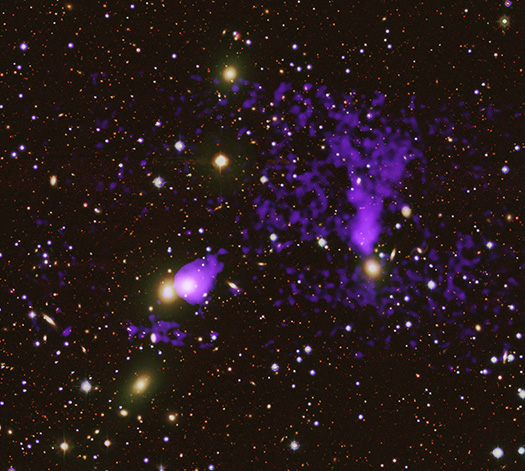
Zwicky 8338
Credit: X-ray: NASA/CXC/Xiamen Univ./C. Ge; Optical: DESI collaboration; Image Processing: NASA/CXC/SAO/N. Wolk
Astronomers using NASA’s Chandra X-ray Observatory have found a galaxy cluster has two streams of superheated gas crossing one another. This result shows that crossing the streams may lead to the creation of new structure.
Researchers have discovered an enormous, comet-like tail of hot gas — spanning over 1.6 million light-years long — trailing behind a galaxy within the galaxy cluster called Zwicky 8338 (Z8338 for short). This tail, spawned as the galaxy had some of its gas stripped off by the hot gas it is hurtling through, has split into two streams.
This is the second pair of tails trailing behind a galaxy in this system. Previously, astronomers discovered a shorter pair of tails from a different galaxy near this latest one. This newer and longer set of tails was only seen because of a deeper observation with Chandra that revealed the fainter X-rays.
Spotted: 'Death Star' Black Holes in Action
Submitted by chandra on Wed, 2024-05-22 11:57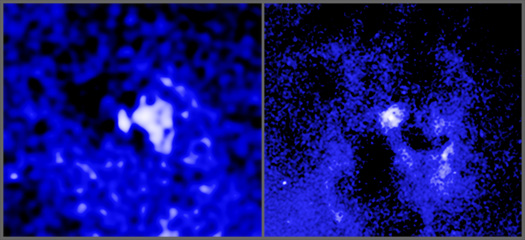
Black Hole "Death Stars," Abell 478 & NGC 5044
Credit: X-ray: NASA/CXC/Univ. of Chicago/S.C. Mackey et al.; Radio: NRF/SARAO/MeerKAT; Image Processing: NASA/CXC/SAO/N. Wolk
A team of astronomers have studied 16 supermassive black holes that are firing powerful beams into space, to track where these beams, or jets, are pointing now and where they were aimed in the past, as reported in our latest press release. Using NASA’s Chandra X-ray Observatory and the U.S. National Science Foundation (NSF) National Radio Astronomical Observatory’s (NRAO) Very Large Baseline Array (VLBA), they found that some of the beams have changed directions by large amounts.
These two Chandra images show hot gas in the middle of the galaxy cluster Abell 478 (left) and the galaxy group NGC 5044 (right). The center of each image contains one of the sixteen black holes firing beams outwards. Each black hole is in the center of a galaxy embedded in the hot gas.
By mousing over the images, labels and the radio images appear. Ellipses show a pair of cavities in the hot gas for Abell 478 (left) and ellipses show two pairs of cavities for NGC 5044 (right). These cavities were carved out by the beams millions of years ago, giving the directions of the beams in the past. An X shows the location of each supermassive black hole.
NASA's Chandra Identifies an Underachieving Black Hole
Submitted by chandra on Thu, 2024-03-21 09:39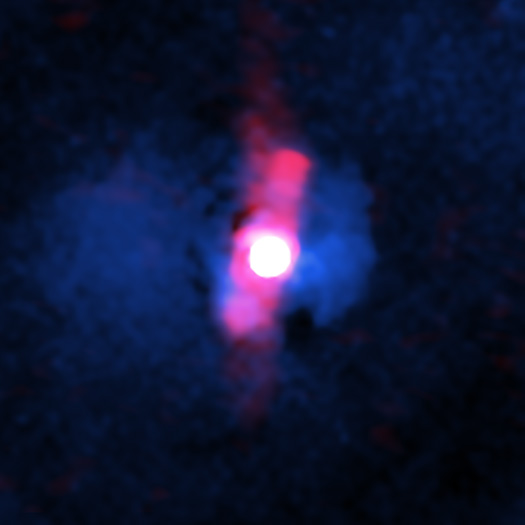
Quasar H1821+643
Credit: X-ray: NASA/CXC/Univ. of Nottingham/H. Russell et al.; Radio: NSF/NRAO/VLA; Image Processing: NASA/CXC/SAO/N. Wolk
This image shows a quasar, a rapidly growing supermassive black hole, which is not achieving what astronomers would expect from it, as reported in our latest press release. Data from NASA’s Chandra X-ray Observatory (blue) and radio data from the NSF’s Karl G. Jansky’s Very Large Array (red) reveal some of the evidence for this quasar’s disappointing impact on its host galaxy.
Known as H1821+643, this quasar is about 3.4 billion light-years from Earth. Quasars are a rare and extreme class of supermassive black holes that are furiously pulling material inwards, producing intense radiation and sometimes powerful jets. H1821+643 is the closest quasar to Earth in a cluster of galaxies.
Quasars are different than other supermassive black holes in the centers of galaxy clusters in that they are pulling in more material at a higher rate. Astronomers have found that non-quasar black holes growing at moderate rates influence their surroundings by preventing the intergalactic hot gas from cooling down too much. This regulates the growth of stars around the black hole.
Chandra Ties Powerful Black Hole to Stellar Beads-on-a-String
Submitted by chandra on Wed, 2024-02-21 12:05
Osase Omoruyi with her parents’ favorite beads.
We are happy to welcome Osase Omoruyi as a guest blogger. Osase is the first author of the paper that is the focus of our latest press release, and is an NSF Graduate Research Fellow at Harvard University, where she is currently completing her PhD in Astronomy and Master’s in History of Science. Osase uses a variety of telescopes, from X-ray through Radio, as well as computer simulations, to study the fascinating life of galaxies. She is particularly interested in how stars and black holes, which are small in comparison to the scale of a whole galaxy, can transform how galaxies change over time.
In 2008, astronomers using the Wisconsin–Indiana–Yale NOAO (WIYN) telescope in Arizona published images of the newly discovered galaxy cluster named SDSS J1531+3414 (SDSS J1531 for short). At first glance, it seemed like a standard massive cluster of galaxies with one giant galaxy in its center, hundreds of others surrounding it, and arc-like structures caused by gravitational lensing – a phenomenon where the cluster's gravity bends light from galaxies behind it.
However, our understanding of SDSS J1531 changed dramatically in 2014 when the Hubble Space Telescope provided a higher-resolution view of the cluster from space. Contrary to initial beliefs, the heart of the cluster housed not one but two massive galaxies, on course to collide and merge into a single entity. They also featured 19 clusters of young stars wrapped around them in a pattern that resembled beads on a string.
Stellar Beads on a String
Submitted by chandra on Wed, 2024-02-21 09:52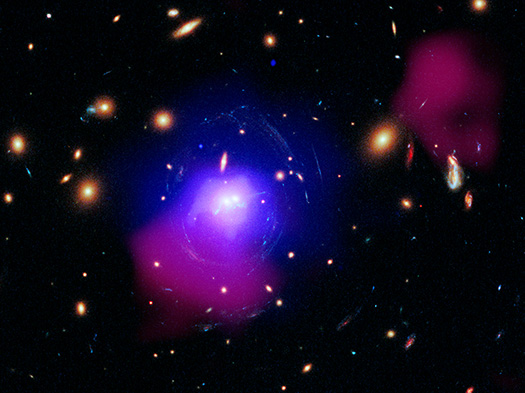
SDSS J1531+3414
Credit: X-ray: NASA/CXC/SAO/O. Omoruyi et al.; Optical: NASA/ESA/STScI/G. Tremblay et al.;
Radio: ASTRON/LOFAR; Image Processing: NASA/CXC/SAO/N. Wolk
Astronomers have discovered one of the most powerful eruptions from a black hole ever recorded in the system known as SDSS J1531+3414 (SDSS J1531 for short). As explained in our press release, this mega-explosion billions of years ago may help explain the formation of a striking pattern of star clusters around two massive galaxies, resembling “beads on a string.”
SDSS J1531 is a massive galaxy cluster containing hundreds of individual galaxies and huge reservoirs of hot gas and dark matter. At the center of SDSS J1531, which is located about 3.8 billion light-years away, two of the cluster’s largest galaxies are colliding with each other.
Astronomers used several telescopes to study SDSS J1531 including NASA’s Chandra X-ray Observatory, and the Low Frequency Array (LOFAR), a radio telescope. This composite image shows SDSS J1531 in X-rays from Chandra (blue and purple) that have been combined with radio data from LOFAR (dark pink) as well as an optical image from the Hubble Space Telescope (appearing as yellow and white). The inset gives a close-in view of the center of SDSS J1531 in optical light, showing the two large galaxies and a set of 19 large clusters of stars, called superclusters, stretching across the middle. The image shows these star clusters are arranged in an ‘S’ formation that resembles beads on a string.
Astronomers Find Spark of Star Birth Across Billions of Years
Submitted by chandra on Wed, 2024-01-10 14:49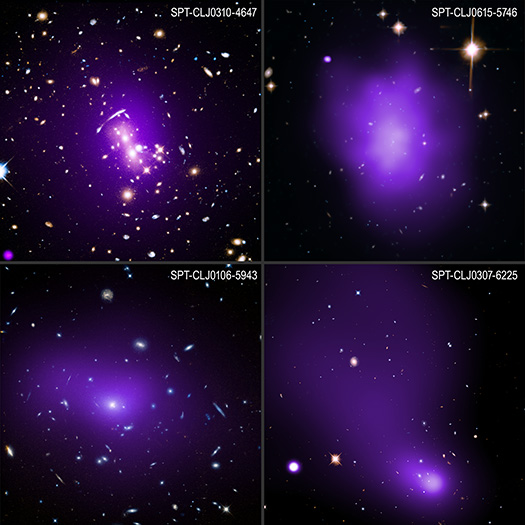
Brightest Cluster Galaxies Survey
Credit: X-ray: NASA/CXC/MIT/M. Calzadilla el al.; Optical: NASA/ESA/STScI;
Image Processing: NASA/CXC/SAO/N. Wolk & J. Major
These four images represent a sample of galaxy clusters that are part of the largest and most complete study to learn what triggers stars to form in the universe’s biggest galaxies, as described in our latest press release. This research, made using NASA’s Chandra X-ray Observatory and other telescopes, showed that the conditions for stellar conception in these exceptionally massive galaxies have not changed over the last ten billion years.
Galaxy clusters are the largest objects in the universe held together by gravity and contain huge amounts of hot gas seen in X-rays. This hot gas weighs several times the total mass of all the stars in all the hundreds of galaxies typically found in galaxy clusters. In the four galaxy cluster images in this graphic, X-rays from hot gas detected by Chandra are in purple and optical data from NASA’s Hubble Space Telescope, mostly showing galaxies in the clusters, are yellow and cyan.
NASA Telescopes Discover Record-Breaking Black Hole
Submitted by chandra on Mon, 2023-11-06 09:08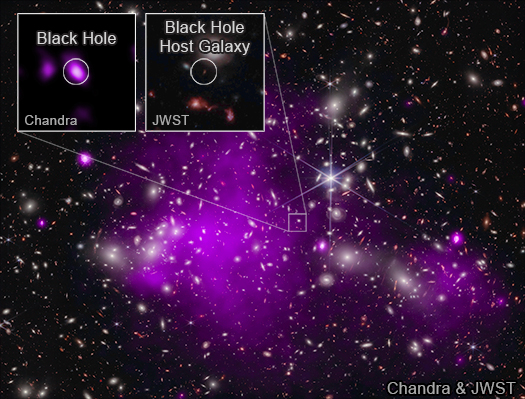
UHZ1
Credit: X-ray: NASA/CXC/SAO/Ákos Bogdán; Infrared: NASA/ESA/CSA/STScI; Image Processing: NASA/CXC/SAO/L. Frattare & K. Arcand
This image contains the most distant black hole ever detected in X-rays, a result that may explain how some of the first supermassive black holes in the universe formed. As we report in our press release, this discovery was made using X-rays from NASA’s Chandra X-ray Observatory (purple) and infrared data from NASA’s James Webb Space Telescope (red, green, blue).
The extremely distant black hole is located in the galaxy UHZ1 in the direction of the galaxy cluster Abell 2744. The galaxy cluster is about 3.5 billion light-years from Earth. Webb data, however, reveal that UHZ1 is much farther away than Abell 2744. At some 13.2 billion light-years away, UHZ1 is seen when the universe was only 3% of its current age.
"El Gordo": A Galaxy Cluster That Pushes the Limits
Submitted by chandra on Wed, 2023-08-02 10:01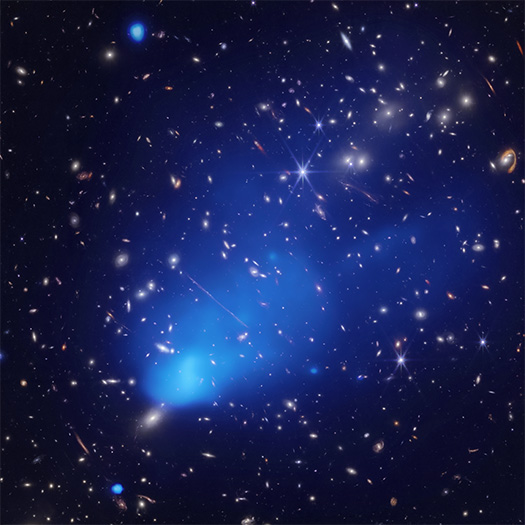
El Gordo
Credit: X-ray: NASA/CXC/Rutgers/J. Hughes et al.; Infrared: NASA/ESA/CSA, J.M. Diego (IFCA), B.Frye (Univ. of Arizona), P.Kamieneski, T.Carleton & R.Windhorst (ASU);
When astronomers discovered the galaxy cluster ACT-CL J0102-4915 in 2012 with NASA's Chandra X-ray Observatory and ground-based optical telescopes, they nicknamed it "El Gordo" (Spanish for the "Fat One") because of its gigantic mass. Scientists estimate that El Gordo contains as much as 3 million billion (3,000,000,000,000,000) times the mass of the Sun. Thanks to its heft, El Gordo acts as a natural lens, distorting the light from more distant objects behind it through a process known as gravitational lensing.
A new composite image of El Gordo shows the diffuse, superheated gas in the cluster observed in X-rays from Chandra (blue) that have been combined with a new infrared image from NASA's James Webb Space Telescope (red, green, and blue). Webb's image shows galaxies in El Gordo plus background galaxies located further away from Earth. El Gordo is located about 7.3 billion light-years from Earth and the background galaxies are at a range of different distances including several that are 12.3 billion light-years from Earth. The appearance of some of the background galaxies has been distorted into a variety of unusual and highly elongated shapes because of gravitational lensing by the cluster.
Unexpectedly Calm and Remote Galaxy Cluster Discovered
Submitted by chandra on Tue, 2023-07-18 13:52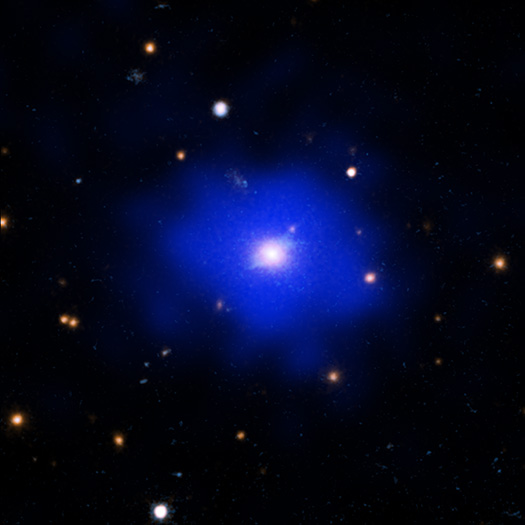
Credit: X-ray: NASA/CXC/MIT/M. Calzadilla; UV/Optical/Near-IR/IR: NASA/STScI/HST; Image processing: N. Wolk
The discovery of the most distant galaxy cluster with a specific important trait – as described in our press release – is providing insight into how these gigantic structures formed and why the universe looks like it does in the present day.
Galaxies Go on a Deep Dive and Leave Fiery Tail Behind
Submitted by chandra on Tue, 2023-06-06 12:15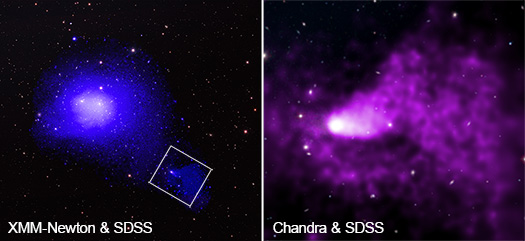
NGC 4839
Credit: X-ray: Chandra: NASA/SAO/Univ. of Alabama/M. S. Mirakhor et al.; XMM: ESA/XMM-Newton;
Optical: SDSS; Image processing: N. Wolk
A group of galaxies is plunging into the Coma galaxy cluster and leaving behind an enormous tail of superheated gas. Astronomers have confirmed this is the longest known tail behind a galaxy group and used it to gain a deeper understanding of how galaxy clusters – some of the largest structures in the universe – grow to their enormous sizes.
Pages
Please note this is a moderated blog. No pornography, spam, profanity or discriminatory remarks are allowed. No personal attacks are allowed. Users should stay on topic to keep it relevant for the readers.
Read the privacy statement
